WISCONSIN (Milwaukee, Madison, Green Bay, Eau Claire)
Located in the north-central, Midwest and Great Lakes regions of the country, it is bordered by Minnesota to the west, Iowa to the southwest, Illinois to the south, Lake Michigan to the east, Michigan to the northeast, and Lake Superior to the north. Wisconsin is the 23rd largest state by total area and the 20th most populous. The state capital is Madison, and its largest city is Milwaukee, which is located on the western shore of Lake Michigan.
Wisconsin’s geography is diverse, having been greatly impacted by glaciers during the Ice Age with the exception of the Driftless Area. The Northern Highland and Western Upland along with a part of the Central Plain occupies the western part of the state, with lowlands stretching to the shore of Lake Michigan. Wisconsin is second to Michigan in the length of its Great Lakes coastline.
During the 19th and early 20th centuries, many European settlers entered the state, many of whom emigrated from Germany and Scandinavia. Like neighboring Minnesota, the state remains a center of German American and Scandinavian American culture.
The state is one of the nation’s leading dairy producers and is known as “America’s Dairyland”; it is particularly famous for its cheese. Manufacturing (especially paper products), information technology (IT), cranberries, ginseng, and tourism are also major contributors to the state’s economy.
Kenosha (pop 100,000) is on the southwestern shore of Lake Michigan. Early archaeological sites antedate the Clovis culture, making them contemporaneous with the ice age. Paleo Indians settled in the area at least 13,500 years ago. Thousands of fish were entering the rivers from Lake Michigan. Harvesting these fish provided food for the coming months.
The land was ceded by the Potawatomi in 1833, when they sold the last of their land as they had hoped to protect their land claims by fighting alongside the United States in the Black Hawk War of 1832, but growing poverty forced them to sell their land in exchange for territory in Iowa and economic investments in schools and agriculture.
The first white settlers arrived in the early 1830s from Hannibal and Troy, New York. In the ensuing years, the area became an important Great Lakes shipping port, In 1850, they adopted its current name, adapted from the Chippewa word Kinoje, which means pike or pickerel.
Between 1902 and 1988, Kenosha produced millions of automobiles and trucks under marques such as Jeffery, Rambler, Nash, Hudson, LaFayette, and American Motors Corporation (AMC).
Kenosha has 21 locations and three districts listed on the National Register of Historic Places including the Library Park, Third Avenue, and the Civic Center historic districts. Landmarks are the 1929 YMCA at 711 59th Place, the Manor House at 6536 Third Avenue, the John McCaffary House at 5732 13th Court, the St. Matthew Episcopal Church at 5900 Seventh Avenue, the Washington Park Clubhouse at 2205 Washington Road, and the Justin Weed House at 3509 Washington Road.
Johnson Wax Headquarters, Racine. In the NM “Modern Architecture Buildings” series, this is the world headquarters and administration building of S. C. Johnson & Son designed by Frank Lloyd Wright and built between 1936 to 1939. Its distinctive “lily pad” columns and other innovations revived Wright’s career at a point when he was losing influence. It and the nearby 14-story Johnson Wax Research Tower (built 1944–1950) were designated as a National Historic Landmark in 1976.
The building features Wright’s interpretation of the streamlined Art Moderne style popular in the 1930s that features many curvilinear forms and subsequently required over 200 different curved “Cherokee red” bricks to create the sweeping curves of the interior and exterior. The warm, reddish hue of the bricks was used in the polished concrete floor slab as well; the white stone trim and white dendriform columns create a subtle yet striking contrast. All of the furniture, manufactured by Steelcase, was designed for the building by Wright and it mirrored many of the building’s unique design features.
Throughout the “Great Workroom,” a series of the thin, white dendriform columns rise to spread out at the top, forming a ceiling, the spaces in between the circles are set with skylights made of Pyrex glass tubing. At the corners, where the walls usually meet the ceiling, the glass tubes continue up, over and connect to the skylights creating a clerestory effect and letting in a pleasant soft light. The Great Workroom is the largest expanse of space in the Johnson Wax Building, and it features no internal walls.
The Research Tower is one of only two existing high rise buildings by Frank Lloyd Wright. Cantilevered from a giant stack, the tower’s floor slabs spread out like tree branches, providing for the segmentation of departments vertically. Freed from peripheral supporting elements, the tower rises gracefully from a garden and three fountain pools that surround its base while a spacious court on three sides provides ample parking for employees. The Research Tower is no longer in use because of the change in fire safety codes although the company is committed to preserving the tower as a symbol of its history.[
In 2008, the U.S. National Park Service submitted the Johnson Wax Headquarters and the Research Tower, along with nine other Frank Lloyd Wright properties, to a tentative list for World Heritage Status. The ten sites have been submitted as one total site. However, a revised nomination in 2011 removed the Johnson Wax Headquarters and the Research Tower from the list.
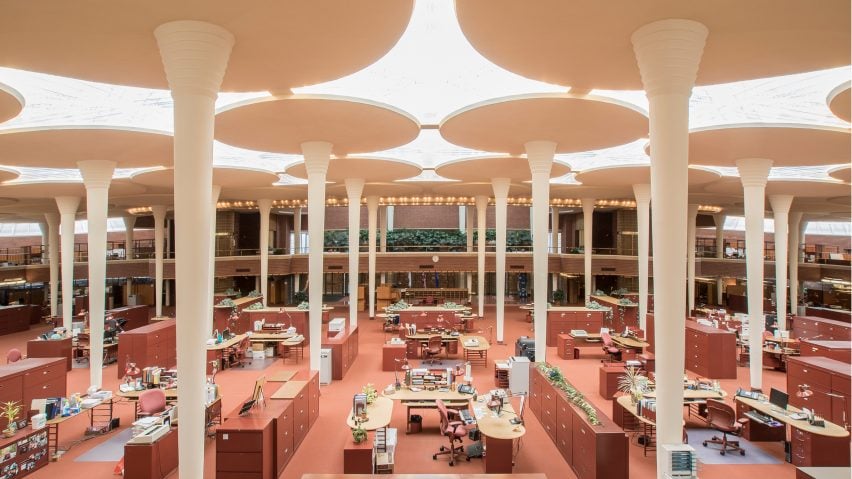
Wind Point Lighthouse, Wind Point. Located at the north end of Racine Harbor, it stands 108 feet (33 m) tall and is one of the oldest and tallest active lighthouses on the Great Lakes. The lighthouse was constructed in 1880. The beacon was originally powered by a three-wicked kerosene lamp, magnified by a third-order Fresnel lens. The light was electrified in 1924, and replaced a DCB-24R airport beacon in 1964. The DCB-24R failed in 2007, and was replaced by a VRB-25 lens.
MILWAUKEE (pop 596,000), metropolitan 2,043,000)
Milwaukee is the largest city in the state of Wisconsin and on Lake Michigan’s western shore. The first Europeans to pass through the area were French Catholic Jesuit missionaries, who were ministering to Native Americans, and fur traders. In 1818, the French Canadian explorer Solomon Juneau settled in the area, and in 1846, was incorporated. Large numbers of German immigrants arrived during the late 1840s, with Poles and other eastern European immigrants arriving in the following decades. Milwaukee is known for its brewing traditions, begun with the German immigrants.
Beginning in the early 21st century, the city has been undergoing its largest construction boom since the 1960s. Major new additions to the city in the past two decades include the Milwaukee Riverwalk, the Wisconsin Center, Miller Park, The Hop (streetcar system), an expansion to the Milwaukee Art Museum, Milwaukee Repertory Theater, and Pier Wisconsin, as well as major renovations to the UW–Milwaukee Panther Arena. In 2018, Milwaukee was named “The Coolest City in the Midwest” by Vogue.
Basilica of St. Josaphat. In its grandeur and opulence it is an excellent example of the so-called Polish Cathedral style of church architecture found in the Great Lakes region of North America. Modelled after St. Peter’s Basilica in Rome, it features one of the largest copper domes in the world.
Poles began trickling into Milwaukee in the 1840s, but the flow increased after the Civil War until their numbers were next only to the German-Americans. The U.S. Post Office and Customs House in Chicago was being razed and 200,000 tons of salvage material were delivered to Milwaukee on 500 railroad flatcars, where parishioners were waiting to begin construction that was finished in 1901.
By seating 2,400 members, it was the city’s largest church. Decoration on the interior was completed in 1928 by artists Conrad Schmitt and Gonippo Raggi. Detailed oil paintings depicting biblical scenes adorned the walls and inner dome, while ornamental plasterwork finished in gold leaf set the columns, and ornate stained glass covered the windows.
Each block was carefully measured and numbered for a best fit in the new design and hardly any stone was re-cut or went to waste. Six large granite columns from the Federal Building, along with their carved stone capitals, were added to the plans. The original ornamental bronze railings, lighting fixtures, and doors were also to be used.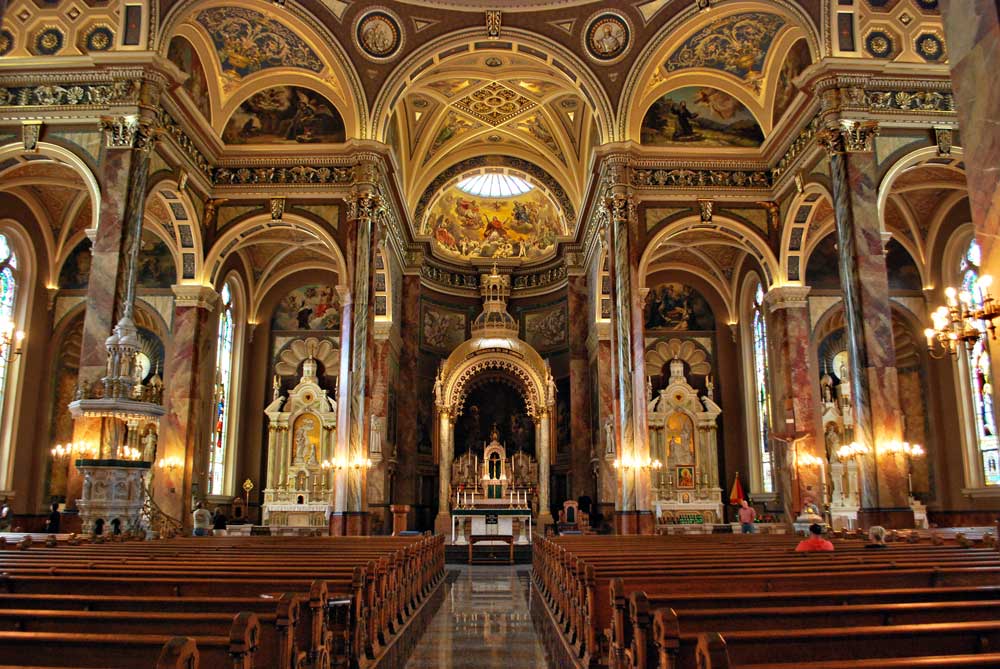
Reiman Footbridge. This pedestrian bridge over N Lincoln Memorial Drive connects the Milwaukee Art Museum on Lake Michigan to the Miller Brewing Company plaza. It is a fantastic cable-stayed bridge supported from a single spar that rises from and is supported by the roof of the museum.
100 East Wisconsin. In the NM “Modern Architecture Buildings” series, is a skyscraper in downtown Milwaukee erected in 1989 on the site of the old Pabst Building. Its design is reflective of the German-American architecture and the third tallest building in Wisconsin.
The location of 100 East Wisconsin at the northwest corner of East Wisconsin avenue and North Water Street has historically been viewed as the oldest building site within the city.
This was the location of Milwaukee’s first European settlement by Henry Vieau, the site of city founder Solomon Juneau’s original cabin and trading post constructed in 1820 and the site of the 235-foot (72 m), 14-story Pabst Building constructed in 1891 and demolished in 1981.
Safe House. In the NM “Bizzarium” series, this “spy bar” is obscure – in a back alley with no signs other than Luraisen Par En Arriere above the letter slot and a city Sanitation Grade A certificate made out to Safe House. A sign for International Exports Ltd 1868 is to the left. Some signs to doors on other sides are Espionage .055km, Intrigue .03km and upward pointing arrows.
Opened in 1966, it is filled wall-to-wall with spy memorabilia collected by founder/owner David J. Baldwin. It has been used as a backdrop in movies shot in Milwaukee such as Major League, and has been featured on the History Channel as one of the best secret locations to visit in the United States. The restaurant has been in featured articles in Time, the Chicago Tribune, People Magazine, and the London Daily Express for its food, spy drinks and espionage-theme. It connects to The Newsroom Pub, also designed by David Baldwin, where autographs of celebrities who have spoken to the Milwaukee Press Club are displayed. The ornate banquet rooms have booths with secret entrances into the Safe House. On June 16, 2015 David Baldwin retired, selling the Safe House to the Marcus Corporation.
M-74 Nike Missile Site, Waukesha. This 30-foot-tall metal tower painted a seafoam green, and its vast concrete pad is what is left from the M74 Nike Missile Base. During the cold war era, it housed all sorts of radar equipment and possible weapons that have since been removed, leaving behind nothing but massive metal bolts and holes in the cement. The base is one of the eight missile sites built around Milwaukee. It was in operation from the mid-1950s to the early 1970s and was meant to protect the city from any enemy attacks.
By the end of the Cold War, the park was abandoned and left to fall into decay. The remaining structure is little more than crumbling cement smeared on exposed bits of metal. There is a massive cylinder in the center, but it leaves a ring of space between the center column and the outer ring of metal sheeting. On top of the tower, colorful graffiti and layers of paint offer a glimpse into locals’ experience at the site, expressing sentiments from “Cross Country Was Here” to “find me on Twitter” to “Save the Bees.”
Be aware that climbing the tower is considered trespassing.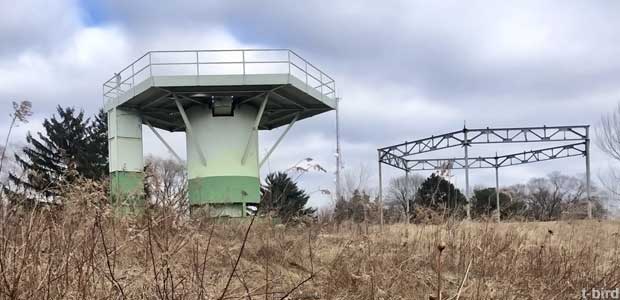
Annunciation Greek Orthodox Church, Wauwatosa. Designed by architect Frank Lloyd Wright in 1956, and completed in 1961, the church is one of Wright’s last works; construction was completed after his death. The design is informed by traditional Byzantine architectural forms, reinterpreted by Wright to suit the modern context.
The predominant symbols of the church – the cross and the dome – dominate the design. The floor plan itself is a Greek cross. Wide arches support the upper level, or balcony. The roof dome sits atop an inverted dome, or bowl. Through simplification and abstraction of the forms, Wright succeeded in artfully translating the cross and the dome from their historical Byzantine context to the vastly dissimilar setting of the twentieth-century American Midwest. Much of the building utilizes a gold-anodized aluminum which, at the time, was a new material that Alcoa established. Since its construction, there have been a few renovations due to structural problems- including the replacement of the dome’s original exterior tile to a synthetic plastic resin.


Bookworm Garden, Sheboygan. Nestled throughout the garden grounds are inspiring nooks and crannies with engaging story-themed exhibits that breathe life into an array of childhood favorites. Chipmunks, turkeys, goldfish, butterflies, lady bugs, owls and a variety of birds prance through the gardens as delighted by the ambiance as the children and adults who join them. Discover hidden literary treasures throughout the gardens, and curl up to enjoy reading an inspirational story from childhood classics of today and yesterday. Admission is free.
After Sheboygan, I drove straight west to the center of the state to visit a second cousin I had never met. It was a delightful day talking and watching all the birds that congregate at her feeders.
After going to Minnesota, I returned to northern Wisconsin on my way to the upper peninsula of Michigan.
Davidson Mill, Superior. Built by Finnish immigrant and homesteader Jacob (Tapola) Davidson in 1904-6, it served Old-Brule and Lakeside on the south shore of Lake Superior. It was used for milling locally grown grain for both animals and humans. It is octagonal with white metal siding and a rotating green cap.
Also on the site are the Eskolen House (a Finnish style log building built in 1905 and moved here in 2007), and the Taylon Bridge.
Bayview (pop 487). This tourist town sits opposite the Apostle Islands, a kayaking destination.
NOMAD MANIA Wisconsin (Milwaukee, Madison, Green Bay, Eau Claire)
World Heritage Sites: Frank Lloyd Wright Buildings
Sights (Temporarily Reinstated): Wisconsin: Breweries, Milwaukee
Islands: Navarino
Borders
Canada (Ontario)-United States
United States of America 48 states (sea border/port)
XL: Door Peninsula (Wisconsin)
Villages and Small Towns
Bayfield
Egg Harbor
Elkhart Lake
Fish Creek
Mineral Point
New Glarus
Museums:
Baraboo: Circus World Museum
La Crosse: Mississippi Valley Archaeology Center
La Crosse: Riverside Museum
House Museums/Plantations
Greenbush: Wade House Historic Site
Spring Green: Taliesin
Religious Temples: Wauwatosa: Annunciation Greek Orthodox Church
Modern Architecture Buildings: Racine: Johnson Wax Headquarters
Festivals: Summerfest, Milwaukee
Botanical Gardens: Hales Corners: Boerner Botanical Gardens
Theme Parks
Marshall: Little Amerricka Amusement Park
Wisconsin Dells: Mt. Olympus
Lighthouses: Wind Point: Wind Point Lighthouse
Windmills
Little Chute: Little Chute Windmill
Superior: Davidson Mill
Maritime/Ship Museums: Manitowoc: Wisconsin Maritime Museum
Aviation Museums: Oshkosh: EAA AirVenture Museum
Railway Museums: North Freedom: Mid-Continent Railway Museum
Vehicle Museums: Hartford: Wisconsin Automotive Museum
Bizzarium
Middleton: National Mustard Museum
Sheboygan: Bookworm Garden
Spring Green: House on a Rock
Waukesha: M-74 Nike Missile Site
Cities of the Americas
GREEN BAY
Museums: Wisconsin – Green Bay: Neville Public Museum
Botanical Gardens: Green Bay Botanical Garden
Railway Museums: National Railroad Museum
KENOSHA
Railway, Metro, Funiculars, Cable Cars: Kenosha Streetcar
MADISON
Airports: Madison (MSN)
Museums:
Chazen Museum of Art
Madison Museum of Contemporary Art
Wisconsin Geology Museum
Wisconsin Historical Museum
Wisconsin Science Museum
Wisconsin Veterans Museum
Modern Architecture Buildings: Monona Terrace
Botanical Gardens:: Olbrich Botanical Gardens
Pedestrian Bridges: Tenney Park Bridges
MILWAUKEE
Airports: Milwaukee (MKE)
Railway, Metro, Funiculars, Cable Cars: The Hop
Museums:
Discovery World Museum
Grohmann Museum
Haggerty Museum of Art
Jewish Museum Milwaukee
Milwaukee Art Museum
Milwaukee Public Museum
Wisconsin Black Historical Society/Museum
Religious Temples: Basilica of St. Josaphat
Modern Architecture Buildings: 100 East Wisconsin
Zoos: Milwaukee County Zoo
Botanical Gardens: Mitchell Park Horticultural Conservatory
Pedestrian Bridges: Reiman Bridge
Vehicle Museums: Harley-Davidson Museum
The Dark Side: America’s Black Holocaust Museum
Bizzarium: Safe House
++++++++++++++++++++++++++++++++++++++++++++++++++++++++++++++
MINNESOTA (Minneapolis, Duluth, Bemidji)
Minnesota is in the Upper Midwest and Great Lakes regions. The state has many lakes, and is known as the “Land of 10,000 Lakes”. Minnesota is the 12th largest in area and the 22nd most populous of the U.S. states; nearly 55% of its residents live in the Minneapolis–Saint Paul metropolitan area (known as the “Twin Cities”). This area has the largest concentration of transportation, business, industry, education, and government in the state.
The geography of the state consists of western prairies now given over to intensive agriculture; deciduous forests in the southeast, now partially cleared, farmed, and settled; and the less populated North Woods, used for mining, forestry, and recreation.
Thousands of years before Europeans arrived, Minnesota was inhabited by various indigenous peoples. French explorers, missionaries, and fur traders began exploring the region in the 17th century, encountering the Dakota and Ojibwe/Anishinaabe tribes. Much of what is now Minnesota was part of the vast French holding of Louisiana, which was purchased by the United States in 1803. Following several territorial reorganizations, Minnesota in its current form was admitted as the country’s 32nd state on May 11, 1858. Like many Midwestern states, it remained sparsely populated and centered on lumber and agriculture. During the 19th and early 20th centuries, many European immigrants, mainly from Scandinavia and Germany, began to settle the state, which remains a center of Scandinavian American and German American culture.
Minnesota’s standard of living index is among the highest in the United States, behind only Massachusetts and Connecticut, and the state is also among the best-educated and wealthiest in the nation. In recent years, its economy has greatly diversified, shifting from traditional activities such as agriculture and resource extraction to services and finance. While Minnesota’s population is still largely dominated by Scandinavian- and German-Americans, domestic migration and immigration from Asia, the Horn of Africa, the Middle East, and Latin America have broadened the demographics of the state.
Lanesboro (pop 754). Named after F. A. Lane, an early landowner, the South Fork of the Root River flows through it, with a waterfall dam across from Sylvan Park. The Root River State Trail and other bike paths also serve the town. An Amish community is in the area and the town is home to many unique shops and restaurants, and a professional stage theater.
Lanesboro received the Great American Main Street Award in 1998. Author John Villani named the community one of the 100 Best Small Art Towns in America. It has also been rated one of the “50 Best Outdoor Sports Towns” by Sports Afield magazine.
Every Saturday before Father’s Day in June, an art festival organized by Lanesboro Arts, dubbed “Art in the Park,” fills the town’s Sylvan Park. During the first August, the popular “Buffalo Bill Days” is held, celebrating one of Lanesboro’s famous frequent visitors, Buffalo Bill. In 2008, the governor of Minnesota declared Lanesboro the Rhubarb Capital of Minnesota. The first weekend in June Lanesboro hosts a Rhubarb Festival.
Rochester (pop 117,000, metropolitan 220,000) is a city founded in 1854 on the Zumbro River’s south fork in Southeast Minnesota 85 miles (137 km) southeast of Minneapolis-St. Paul. It is Minnesota’s third-largest city and the largest city located outside the Minneapolis-St. Paul Metropolitan Statistical Area. It is the home of the Mayo Clinic and a major IBM facility, one of the company’s largest at its peak. The city has long been rated as one of the best places to live in the United States by multiple publications such as Money.
The area developed as a stagecoach stop between Saint Paul, Minnesota, and Dubuque, Iowa near the Zumbro River. In 1863, Dr. William W. Mayo arrived as the examining surgeon for Union draftees in the Civil War. Rochester celebrated its sesquicentennial in 2004. In 1883, the Great Tornado demolished much of Rochester, leaving 37 dead and approximately 200 injured. As there was no medical facility in the immediate area at the time, Dr. Mayo and his two sons worked together to care for the wounded. Donations of US$60,000 (US$1,567,054 in 2016 accounting for inflation) were collected and the Sisters of St. Francis, assisted by Mayo, opened a new facility named St. Marys Hospital in 1889.
The Mayo practice grew and is today among the largest and most well-respected medical facilities in the world and it has been consistently ranked No. 1 Best hospital in the United States by U.S. News & World Report.
Located in southeast Minnesota, the City of Rochester falls within the Driftless Area: the only region in North America that was never glaciated and contains deeply-carved river valleys. The rugged terrain is due both to the lack of glacial deposits, or drift, and to the incision of the upper Mississippi River and its tributaries into bedrock.
Rochester has an extensive parks system, the largest of which are Silver Lake and Soldiers Field in the central part of the city. A major flood in 1978 led the city to embark on an expensive and successful flood-control project that involved altering many nearby rivers and streams.
MINNEAPOLIS (pop 425,000, metropolitan 3.63 million)
Minneapolis is the largest city in Minnesota and its neighbor Saint Paul make up the Twin Cities, with Minneapolis being the larger of the two. Minneapolis lies on both banks of the Mississippi River, just north of the river’s confluence with the Minnesota River, and adjoins Saint Paul, the state’s capital. The city is abundantly rich in water, with 13 lakes, wetlands, the Mississippi River, creeks and waterfalls; many connected by parkways in the Chain of Lakes and the Grand Rounds National Scenic Byway. It was once the world’s flour milling capital and a hub for timber.
Minneapolis has one of the largest LGBT populations in the U.S. Noted for its strong music and performing arts scenes, Minneapolis is home to both the award-winning Guthrie Theater and the historic First Avenue nightclub. Reflecting the region’s status as a center of folk, funk, and alternative rock music, the city served as the launching pad for several of the 20th century’s most influential musicians, including Bob Dylan and Prince. The present name is derived from Minnehaha, and combined mni, a Dakota word for water, and polis, the Greek word for city.
The Dakota Sioux were the region’s sole residents when French explorers arrived in 1680. Gradually, more European-American settlers arrived, competing for game and other resources with the Native Americans. Fort Snelling was built in 1819 by the U.S. Army as the U.S. military’s most remote outpost, to direct Indian trade away from the French and English to the U.S. The fort attracted traders, settlers and merchants, spurring growth. The U.S. government pressed the Dakota to sell their land which was ceded in a succession of treaties. The U.S. reneged on the treaties during the Civil War, resulting in hunger, war, internment, and exile of the Dakota from Minnesota.
Minneapolis developed around Saint Anthony Falls, the highest waterfall on the Mississippi River and a source of power for its early industry. Forests in northern Minnesota were a valuable resource for the lumber industry, which operated seventeen sawmills on power from the waterfall. The farmers of the Great Plains grew grain that was shipped by rail to the city’s 34 flour mills. Between 1880 and 1930 were so remarkable the city has been described as “the greatest direct-drive waterpower center the world has ever seen. Processing by steel and porcelain roller mills were capable of producing premium-quality pure white flour very quickly. Charles A. Pillsbury and the C.A. Pillsbury Company across the river were barely a step behind, hiring Washburn employees to immediately use the new methods. The hard red spring wheat that grows in Minnesota became valuable ($0.50 profit per barrel in 1871 increased to $4.50 in 1874), and Minnesota “patent” flour was recognized at the time as the best in the world.
Not until later did consumers discover the value in the bran (which contains wheat’s vitamins, minerals and fiber) that “…Minneapolis flour millers routinely dumped” into the Mississippi.
In 1910, a Minneapolis developer started writing restrictive covenants based on race and ethnicity into his deeds. Copied by other developers, the practice prevented minorities from owning or leasing such properties. The Ku Klux Klan succeeded by entering family life, but effectively was a force in the city only from 1921 until 1923. From the end of World War I until 1950, Minneapolis was a “particularly virulent” site of anti-semitism. A hate group known as the Silver Legion of America recruited members in the city and held meetings around 1936 to 1938.
Mall of America is a shopping mall in Bloomington, a suburb of the Twin Cities. Opened in 1992, it is the largest mall in the United States in terms of total floor area and the fifth largest mall in North America in terms of leasable space and the twelfth largest in the world. The mall’s concept was designed by the Triple Five Group, owned by the Ghermezian brothers, who also own the largest shopping mall in North America, the West Edmonton Mall.
Its anchors were Nordstrom, Macy’s, Bloomingdale’s and Sears (closed in 2019). The Mall of America’s 42 million annual visitors equal roughly eight times the population of the state of Minnesota. The mall is nearly symmetric, with a roughly rectangular floor plan. More than 530 stores are arranged along three levels of pedestrian walkways on the sides of the rectangle, with a fourth level on the east side. Four anchor department stores are located at the corners.
Despite Minnesota’s cold winters, only the mall’s entrances and some below ground areas are heated. Heat is allowed in through skylights above the central amusement park area. The majority of the heat is produced by lighting fixtures, other electric devices and people in the mall.
Nickelodeon Universe is an indoor theme park in the center of the mall. The park features roller coasters, among numerous other rides and attractions, including many not related to Nickelodeon, and is the largest indoor theme park in the United States. At the Sea Life Minnesota Aquarium, guests travel through a 300-foot-long (91 m) curved tunnel through 14 feet (4.3 m) of water to view over 4,500 sea creatures including sharks, turtles, stingrays and many more.
Basilica of Saint Mary is a Roman Catholic minor basilica in downtown Minneapolis. It was the first basilica established in the United States. Designed it in a Beaux-Arts style, it was built between 1907-1913 with the interior decoration completed by 1925. Its significance is due to three reasons: its excellent architecture and engineering design, as an expression of Baroque influence in church architecture; an example of the history of religious movements in Minnesota; and its place as the first basilica in the United States.
The foundation is Rockville granite, the 70 foot walls white Vermont granite and the main entrance a colonnaded portico with two 116-foot (35 m) spires on each side. The nave is lighted by five large arched stained glass windows. The nave has a barrel vault of 82 feet (25 m), exceeding that of the St. Peter’s Basilica by two feet. The sanctuary, at the north end of the nave, is topped with a grand dome measuring 40 square feet (3.7 m2) at the base and rising 138 feet (42 m) above the floor. Above the dome is a flesche or lantern topped with a bronze cross, measuring another 62 feet (19 m), making the total height 200 feet (61 m) above floor level. The marble altar is located underneath a 50-foot-high (15 m) marble-columned baldacchino.

The following are in the NM “Modern Architecture Buildings” series.
Guthrie Theater. Founded in 1963, it is a center for theater performance, production, education, and professional training in Minneapolis, The first building included a 1,441-seat that operated from 1963–2006 and then moved to its current facility However, demolition started in late 2006 beginning with the common area between the old Guthrie building and the Walker. The site has been turned into green space and an extension of the Minneapolis Sculpture Garden.
In 2006, the Guthrie finished construction of a new $125 million theater building along the Mississippi River in downtown Minneapolis. The 285,000 square foot facility houses three theaters: (1) the theater’s signature thrust stage, seating 1,100, (2) a 700-seat proscenium stage, and (3) a black-box studio with flexible seating. It also has a 178-foot cantilevered bridge (called the “Endless Bridge”) to the Mississippi. The outside of the building’s walls are covered in large panels which display a large mural of photographs from past plays visible clearly at night.
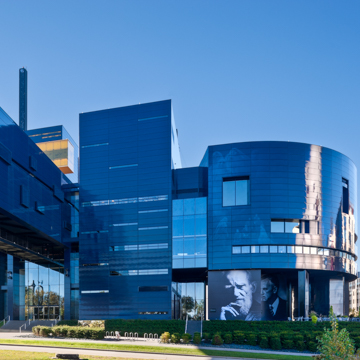
IDS Center is an office skyscraper completed in 1972 and the tallest building in Minneapolis, The structure rises to 910 feet (10,900 in) when including communications spires on the roof. The IDS was constructed as the headquarters of Investors Diversified Services, Inc.—now Ameriprise Financial.
The complex consists of five parts: the 57-story IDS Tower itself, an 8-story annex building along Marquette Avenue, the 19-story Marquette Hotel at 7th Street & Marquette Avenue, and a 2-story retail building that was originally dominated by Woolworth’s. These four buildings are joined by the 7-story Crystal Court.
Marquette Plaza. This highrise in downtown Minneapolis, it is designed much like a suspension bridge, most of the original floors are supported by two sets of catenary cables. While the building’s design has been highly praised as an engineering achievement, it was plagued with design defects that led to leaky windows and other problems. In addition, asbestos had been heavily used in the building’s construction. The building was remodelled in 2002 for about US$65 million.

Wells Fargo Center is the third-tallest building in Minneapolis. Completed in 1988, it is 774 feet (235.6 m) tall. It was designed with a modernized art deco style and is brilliantly lit at night from sunset through midnight. It was recognized by the United States EPA as one of the 100 most energy efficient buildings in the USA. A branch of the Wells Fargo History Museum is located in the skyway level. The museum’s exhibits include an 1863 stagecoach, telegraph equipment, gold nuggets and coins.
Stone Arch Bridge is a former railroad bridge crossing the Mississippi River at Saint Anthony Falls in downtown Minneapolis. It is the only arched bridge made of stone on the entire Mississippi River. The bridge was built to connect the railway system to the new Union Depot and completed in 1883, costing $650,000 at the time ($17.8 million today). Since the early 1990s, the structure is used as a pedestrian and bicycle bridge.
In 1880, Minneapolis was a bustling city with major commerce mostly located on the west bank of the Mississippi River, while smaller, up-and-coming businesses were on the east. The city’s network of railroads, which was crucial for urbanization, was also located on the east side of the river. It was built between 1883-4 using stone locally sourced, including granite from Sauk Rapids for the piers and magnesium limestone from Mankato and Iowa for the upper portion.
The bridge is just downstream from St Anthony Falls, the only true waterfall on the entire 2,340 mile length of the Mississippi River. St Paul was the head of navigation on the Mississippi.
The bike and walking trails across the bridge are integrated into the city’s park and trail system, and form part of the St Anthony Falls Heritage Trail. The bridge offers views of the Minneapolis skyline, Pillsbury “A” Mill, the Mill City Museum, and many other places in the district, and is near both the restaurants of Main St SE and the Guthrie Theater.
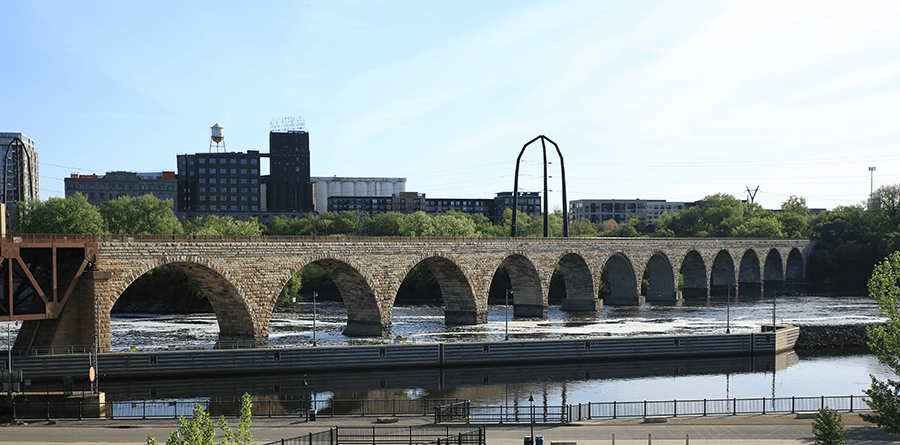
ST. PAUL (pop 308,000)
St Paul is the capital and second-most populous city in Minnesota. The city lies mostly on the east bank of the Mississippi River in the area surrounding its point of confluence with the Minnesota River, and adjoins Minneapolis, the state’s largest city. Known as the “Twin Cities”, the two form the core of Minneapolis–Saint Paul, the 16th-largest metropolitan area in the United States, with about 3.6 million residents.
Founded near historic Native American settlements as a trading and transportation center, the city rose to prominence when it was named the capital of the Minnesota Territory in 1849. Regionally, the city is known for the Xcel Energy Center, home of the Minnesota Wild, and for the Science Museum of Minnesota. As a business hub of the Upper Midwest, it is the headquarters of companies such as Ecolab. Saint Paul, along with its twin city, Minneapolis, is known for its high literacy rate.
Cathedral of Saint Paul is a Roman Catholic cathedral that sits on Cathedral Hill overlooking downtown St. Paul and features a distinctive copper-clad dome. The current building opened in 1915 as the fourth cathedral of the archdiocese to bear this name. The open design allows visitors unobstructed views of the altar and pulpit. In 1987 the Cathedral acquired five bronze bells cast in France. The copper dome was renovated in 2002. The dome of the cathedral is 76 feet (23 m) in diameter and 186 feet (57 m) high. The exterior walls of the cathedral are Rockville granite from St. Cloud and the interior walls are American Travertine from Mankato, Minnesota. The interior columns are made of several types of marble. The interior is illuminated by twenty-four stained glass windows featuring angelic choirs. Heroic size marble statues of the four evangelists, sculpted by John Angel, are set into the niches of the piers in the four corners of the Church. The cathedral also has six chapels dedicated to the patron saints of the European ethnic groups that settled the area around the city: St. Anthony for the Italians, St. John the Baptist for the French Canadians, St. Patrick for the Irish, St. Boniface for the Germans, Saints Cyril and Methodius for the Slavs; and St. Therese of Lisieux for the missionaries.
The Saint Paul Hotel hosted guests as early as 1856 and as it stands today, was built in 1910 boasting handsome Italian Renaissance Revival architecture.
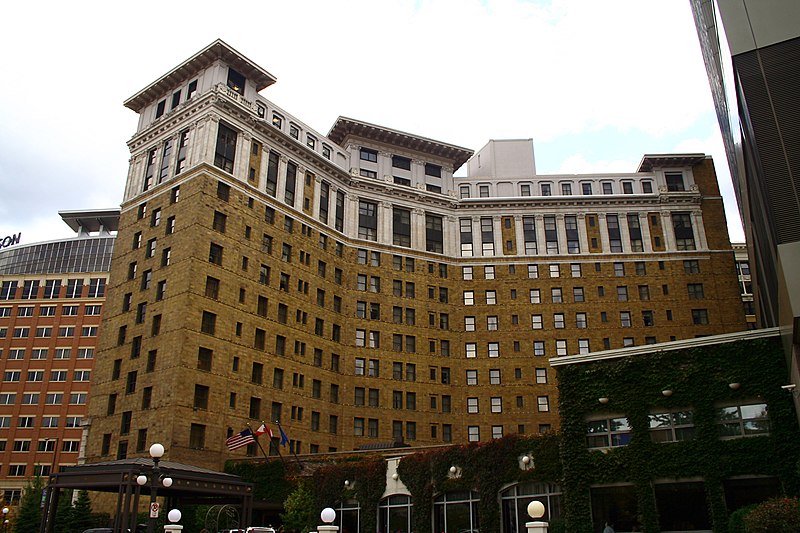
NOMAD MANIA Minnesota (Minneapolis, Duluth, Bemidji)
Borders
Canada (AB, BC, MB, SK)-United States (MN, MT, ND, WA)
Canada (Ontario)-United States
United States of America 48 states (sea border/port)
XL: Northwest Angle (Minnesota)
House Museums/Plantations: Grand Rapids: Judy Garland Museum
World of Nature: Itasca State Park
Zoos: Apple Valley: Minnesota Zoo
Botanical Gardens: Chaska: Minnesota Landscape Arboretum
Theme Parks: Brainerd: Paul Bunyan Land
Lighthouses: Lake County: Split Rock Lighthouse
Windmills: Blue Earth County: Seppman Mill
Caves
Minnehaha Falls
Niagara Cave
Maritime/Ship Museums: Alexandria: Legacy of The Lakes Museum
Open-Air Museums: New York Mills: Finn Creek Museum
Bizzarium: Austin: Spam Museum
Villages and Small Towns
BIWABIK
GRAND MARAIS
LANESBORO
DULUTH*
House Museums/Plantations: Glensheen
Maritime/Ship Museums: SS William A Irvin
Railway Museums: Lake Superior Railroad Museum
Cities of the Americas
ROCHESTER
MINNEAPOLIS World Cities and Popular Towns
Airports: Minneapolis (MSP)
Railway, Metro, Funiculars, Cable Car: Minneapolis-St. Paul: METRO
Museums:
American-Swedish Institute
Katherine E. Nash Gallery
Mill City Museum
Minneapolis Institute of Art
Museum of Russian Art
The Bakken
The Somali Museum of Minnesota
Walker Art Center
Weisman Art Museum
Religious Temples: Basilica of Saint Mary
Modern Architecture Buildings
Guthrie Theater
IDS Center
Marquette Plaza
Wells Fargo Center
Theme Parks: Valleyfair
Malls/Department Stores: Mall of America
Pedestrian Bridges: Stone Arch Bridge
ST. PAUL
Museums: Science Museum of Minnesota
House Museums/Plantations: James J. Hill House
Religious Temples: Cathedral of Saint Paul
Zoos: Como Park Zoo and Marjorie McNeely Conservatory
Hospitality Legends: The Saint Paul Hotel
Aviation Museums: Minnesota Air National Guard Museum
++++++++++++++++++++++++++++++++++++++++++++++++++++++++
MICHIGAN UPPER PENINSULA (Sault Ste. Marie, Marquette)
There is little to see in the Upper Peninsula other than the south shore of Lake Superior and a lot of flat forest land. There was still snow banks in the north facing ditches and all the lakes still mainly frozen.
Redridge Steel Dam is a steel dam across the Salmon Trout River in Redridge, Michigan. Completed in 1901, it is a flat slab buttress dam constructed of steel, a relatively rare material for construction of dams, which are typically made of earthen works, concrete, or masonry. In 1894, prior to the construction of the steel dam, the Atlantic Mining Company built a timber crib dam across the Salmon Trout River. The dam created a reservoir which supplied water to the Atlantic stamp mill which extracted copper from ore-bearing rock. This reservoir proved to be insufficient, and in 1901 the steel dam was built. It was designed by J. F. Jackson and built by the Wisconsin Bridge and Iron Company. The old timber crib dam remained in place, submerged, upstream of the steel dam. A system of spillways, sluices (or launders as they are referred to in contemporary texts), and pipes brought water downhill to the stamp mills. The dam itself measures 74 ft (23 m) high at its center and extends for a length of 1,006 ft (307 m) across the river.
The dam operated for several decades, until the mines closed and the spillway valves opened. Large holes were cut in it in 1979 so that it would not retain water. This lowered the level of the reservoir, revealing the earlier timber dam.
Redridge is one of the more rugged counties in Michigan, and access to the dam site is relatively challenging.
Mackinac Bridge is a suspension bridge spanning the Straits of Mackinac to connect the Upper and Lower Peninsulas of Michigan. Opened in 1957, the 26,372-foot-long (4.995 mi; 8.038 km) bridge (familiarly known as “Big Mac” and “Mighty Mac”) is the world’s 24th-longest main span and the longest suspension bridge between anchorages in the Western Hemisphere. The Mackinac Bridge is part of Interstate 75 and the Lake Michigan and Huron components of the Great Lakes Circle Tour across the straits; it is also a segment of the U.S. North Country National Scenic Trail. The bridge connects the city of St. Ignace on the north end with the village of Mackinaw City on the south.

NOMAD MANIA Michigan Upper Peninsula (Sault Ste. Marie, Marquette)
Sights: Mackinac Island
Islands
Drummond
Isle Royale
Borders
Canada (Ontario)-United States
United States of America 48 states (sea border/port)
XL: Keweenaw Peninsula (Michigan)
Modern Architecture Buildings: Redridge Steel Dam
Caves: Miners Castle Cave
Hospitality Legends: Mackinac Island: Grand Hotel
Maritime/Ship Museums: Paradise: Great Lakes Shipwreck Museum
MICHIGAN LOWER PENINSULA (Detroit, Lansing, Grand Rapids)
White Shoal Light. Built in 1910, this lighthouse is located 20 miles west of the Mackinac Bridge in Lake Michigan. It is an active aid to navigation. It is also the tallest lighthouse on the Great Lakes. The period between 1852 and the beginning of the 20th century saw great activity on the Great Lakes and between 1852 and 1860, 26 new lights were built, a dozen new lights in the 1860s, 43 in the 1870s and more than 100 in the 1880s. As the new century began, there were 334 major lights, 67 fog horns and 563 buoys.
It was a “major engineering feat” because of its distance and isolation from land.
The light has a range of up to 28 miles, is the sole “aluminum-topped” lighthouse on the Great Lakes, and is the only red and white ‘candy cane stripe’, ‘barber pole’ lighthouse in the United States. The best way to see the light is through a variety of boat tours
The area was settled and named by conservative Lutheran immigrants in1845. The purpose of the settlement was primarily religious; the Lutheran group planned to start a mission among the Native Americans. Attempts to convert the locals failed, since most of them moved away. Germans continued arriving until the start of the Second World War.
The German, and in particular, Franconian culture of the town has been preserved and passed down through the generations. The German language is still prevalent in signage and speech and 53% are of German heritage.
Tourism and farming drive the local economy. Frankenmuth draws over three million tourists annually to its Bavarian-themed shops and restaurants such as the Bavarian Inn, Frankenmuth Brewery, Zehnder’s, and Bronner’s Christmas Wonderland.
The architecture features stylistic interpretations of the timber-framed buildings found in the Franconia region of Germany.
Major festivals include Oktoberfest, Frankenmuth Bavarian Festival (a summer celebration of Bavarian culture and values through food, drink, traditional activities and music), Frankenmuth SnowFest (snow-sculpting and ice carving), Frankenmuth Autofest (over 2,500 classic cars and the Frankenmuth Dog Bowl.

Wood Covered bridge. Built in 1979 using traditional covered-bridge timber framing techniques, it is 239 feet and has 2 lanes for cars and two pedestrian walkways.
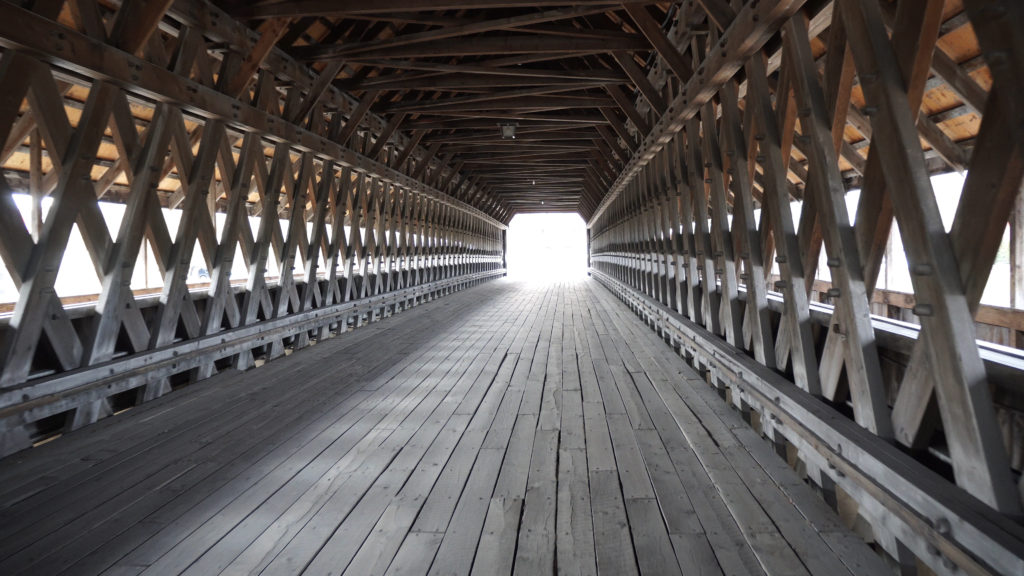
Flint (102,434) Located along the Flint River, 66 miles (106 km) northwest of Detroit, itw was founded in 1819 and became a major lumbering area on the historic Saginaw Trail. During the late 19th century to the mid 20th century, the city was a leading manufacturer of carriages and later automobiles. General Motors (GM) was founded in Flint in 1908, and the city grew into an automobile manufacturing powerhouse for GM’s Buick and Chevrolet divisions, especially after World War II up until the early 1980s recession.
GM significantly downsized from a 1978 high of 80,000 to under 8,000 by 2010. Flint became known for its high crime rates and has repeatedly been ranked among the most dangerous cities in the United States. The city was under a state of financial emergency from 2002–2004 and again from 2011–2015. Since 2014, the city has faced a major public health emergency due to lead contamination in the local water supply that has affected thousands of residents, as well as an outbreak of Legionnaires’ disease due to tainted water.
General Motors Technical Center,. The campus has been the centre of the company’s engineering effort since its inauguration in 1956. The facility cost the company approximately US$100 million at the time. The “Tech Center” is a 710-acre campus that includes 38 buildings and can house over 21,000 employees.
The architectural style and collaborative methods of development were used in his successful applications in other large-scale corporate campus environment for clients including Bell Labs, IBM, and the John Deere World Headquarters.
DETROIT (pop 673,000, metro 4.3 million)
Detroit is the largest and most populous city in Michigan and the largest U.S. city on the United States–Canada border. Regarded as a major cultural center, Detroit is known for its contributions to music and as a repository for art, architecture and design.
Detroit is a major port on the Detroit River, one of the four major straits that connect the Great Lakes system to the Saint Lawrence Seaway.
Detroit and its neighboring Canadian city Windsor are connected through a highway tunnel, railway tunnel, and the Ambassador Bridge, which is the second busiest international crossing in North America, after San Diego–Tijuana. Detroit is best known as the center of the U.S. automobile industry, and the “Big Three” auto manufacturers General Motors, Ford, and Fiat Chrysler are all headquartered in Metro Detroit.
In 1701, Antoine de la Mothe Cadillac founded Fort Pontchartrain du Détroit, the future city of Detroit. During the 19th century, it became an important industrial hub at the center of the Great Lakes region. The city became the 4th-largest in the nation in 1920, after only New York City, Chicago, and Philadelphia with the influence of the booming auto industry. However, due to industrial restructuring, the loss of jobs in the auto industry, and rapid suburbanization, Detroit lost considerable population from the late 20th century to the present. Since reaching a peak of 1.85 million at the 1950 census, Detroit’s population has declined by more than 60 percent. In 2013, Detroit became the largest U.S. city to file for bankruptcy, which it successfully exited in December 2014, when the city government regained control of Detroit’s finances.
Detroit’s diverse culture has had both local and international influence, particularly in music, with the city giving rise to the genres of Motown and techno, and playing an important role in the development of jazz, hip-hop, rock, and punk music. The rapid growth of Detroit in its boom years resulted in a globally unique stock of architectural monuments and historic places. Since the 2000s conservation efforts have managed to save many architectural pieces and achieved several large-scale revitalizations, including the restoration of several historic theatres and entertainment venues, high-rise renovations, new sports stadiums, and a riverfront revitalization project. More recently, the population of Downtown Detroit, Midtown Detroit, and various other neighborhoods has increased. An increasingly popular tourist destination, Detroit receives 19 million visitors per year. In 2015, Detroit was named a “City of Design” by UNESCO, the first U.S. city to receive that designation.
The following are in the NM “Modern Architecture Buildings” series.
Fisher Building. This landmark skyscraper is an ornate 30-story building, completed in 1928. Designed in an Art Deco style, faced with limestone, granite, and several types of marble, it was financed with proceeds from the sale of Fisher Body to General Motors.
The building contains the elaborate 2,089-seat Fisher Theatre and houses the headquarters for the Detroit Public Schools and the studios of radio station WJR.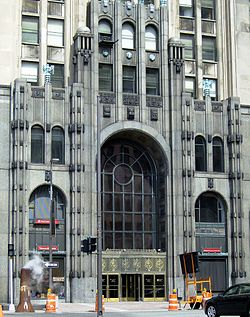
Along with Cadillac Place, the two massive buildings spurred the development of a New Center for the city, a business district north of its downtown area.
it has 30 stories with a roof height of 428 feet with 21 elevators. The opulent three-story barrel vaulted lobby is constructed with forty different kinds of marble,
Guardian Building is a landmark skyscraper in Downtown Detroit. The Guardian is a class-A office building owned by Wayne County and serves as its headquarters. Finished in 1929, it is a bold example of Art Deco architecture, including art moderne designs.
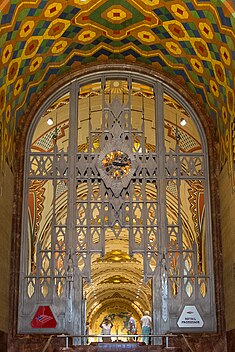
The main frame of the skyscraper rises 36 stories, capped by two asymmetric spires. The roof height is 496 ft and the spire 632 ft (192.6 m). Its nickname, Cathedral of Finance, alludes both to the building’s resemblance to a cathedral, with its tower over the main entrance. Native American themes are common inside and outside the building. The exterior blends brickwork with tile, limestone, and terra cotta. The building’s three story, vaulted lobby is lavishly decorated with Pewabic and Rookwood tile. The building includes works by muralist Ezra Winter in the mosaic above the main lobby desk and the mural at the end of the banking hall. Monel metal is used for all exposed metalwork on the building, Ally Detroit Center is a 43-story, 619 foot tall skyscraper and office building located downtown, the tallest office building in Michigan.
Built in postmodern architecture topped with Flemish-inspired neo-gothic spires, it was constructed from 1991 to 1993. It houses numerous tenants, including many prominent Detroit law firms. Ally Financial occupies 20 floors and it was renamed Ally Detroit Center. Corktown is a historic district located just west of Downtown Detroit, Michigan. It is the oldest extant neighbourhood in the city. The neighborhood was listed on the National Register of Historic Places in 1978. The Corktown Historic District is largely residential, although some commercial properties along Michigan Avenue are included in the district. The neighborhood contains many newer homes and retains some original Irish businesses.
Corktown is a historic district located just west of Downtown Detroit, Michigan. It is the oldest extant neighbourhood in the city. The neighborhood was listed on the National Register of Historic Places in 1978. The Corktown Historic District is largely residential, although some commercial properties along Michigan Avenue are included in the district. The neighborhood contains many newer homes and retains some original Irish businesses.
The Great Irish Potato Famine of the 1840s resulted in extensive Irish migration to the United States and Canada. By the middle of the 19th century, they were the largest ethnic group settling in Detroit. Many of these newcomers settled on the west side of the city; they were primarily from County Cork, and thus the neighbourhood came to be known as Corktown. By the early 1850s, half of the population were of Irish descent. By the Civil War, German immigrants had begun making inroads into the Corktown neighbourhood. Many immigrants had come from German provinces after the revolutions of 1848. By the turn of the century, the original Irish population had diffused through the city, and new immigrants, notably Mexican and Maltese, moved into this older housing.[5] As the century progressed, migrants from the American South and Appalachia, both black and white, were lured by the jobs in the automobile industry and also went to the city. By the middle of the 20th century, the area of Corktown was reduced through urban renewal schemes, the building of light industrial facilities, and the creation of the Lodge Freeway and Fisher Freeway.
Part of the Detroit metropolitan area, it is home to the largest Muslim population in the United States. First settled in the late 18th century by ethnic French farmers in a series of ribbon farms along the Rouge River and the Sauk Trail, the community grew in the 19th century with the establishment of the Detroit Arsenal on the Chicago Road linking Detroit and Chicago. In the 20th century, it developed as a major manufacturing hub for the automotive industry.
Henry Ford was born on a farm here and later established an estate in Dearborn, as well as his River Rouge Complex, the largest factory of his Ford empire. He developed mass production of automobiles, and based the world headquarters of the Ford Motor Company here. The city has a campus of the University of Michigan as well as Henry Ford College. The Henry Ford, the United States’ largest indoor-outdoor historic museum complex and Metro Detroit’s leading tourist attraction, is located here.
Dearborn residents are Americans primarily of European or Middle Eastern ancestry, many descendants of 19th and 20th-century immigrants. Because of new waves of immigration from the Middle East in the late 20th century, the largest ethnic grouping is now composed of descendants of various nationalities of that area: Christians from Lebanon and Palestine, as well as Muslim immigrants from Syria, Iraq, and Yemen.
Islamic Center of America is a mosque located in Dearborn. Although the institution dates back to 1963, the center’s current mosque opened in 2005. It is the largest mosque in North America and the oldest Shia mosque in the United States. With its large Shia Arab population (consisting mostly of Iraqis and Lebanese), Dearborn is often called the “heart of Shiism” in the United States.
The growing number of Muslims in the Detroit area in the mid-20th century sought out a religious leader from the Middle East to serve the community. Imam Muhammad Chirri of Lebanon was invited to lead the newly-formed Islamic Center Foundation Society, which would later turn into the Islamic Center of Detroit, and later the Islamic Center of America.
The mosque was vandalized in January 2007 with anti-Shia graffiti. Many in the community believed that the vandalism was the result of recurrent sectarian tensions with the American Sunni Muslim community over the Iraq War and its Shia–Sunni conflict. On January 24, 2011, an Imperial Beach, California man named Roger Stockham was arrested and charged with terrorism after attempting to blow up the Islamic Center of America. Stockham was reported to be a convert to Sunni Islam who was targeting the Shia community, and had a history of mental illness and firearms offenses. On April 21, 2011, the day before the scheduled appearance of Pastor Terry Jones, hundreds of people from different faiths gathered in a show of solidarity. Jews, Christians and other faith groups stood side by side with inter-locked arms in opposition to Jones’ planned protest.

The Henry Ford. In the NM “Bizzarium” series, (also known as the Henry Ford Museum of American Innovation and Greenfield Village, and as the Edison Institute) is a large indoor and outdoor history museum complex and a National Historic Landmark in the Detroit suburb of Dearborn. The museum collection contains the presidential limousine of John F. Kennedy, Abraham Lincoln’s chair from Ford’s Theatre, Thomas Edison’s laboratory, the Wright Brothers’ bicycle shop, the Rosa Parks bus, and many other historical exhibits. It is the largest indoor-outdoor museum complex in the United States and is visited by over 1.7 million people each year.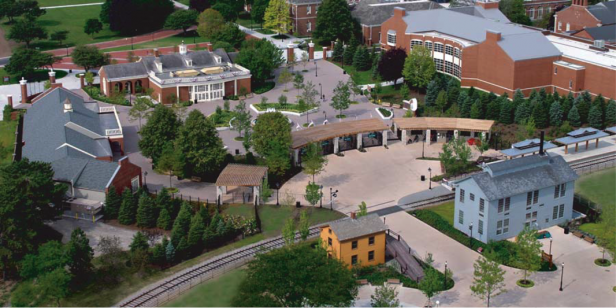
Lost Peninsula is a small exclave situated between the Maumee and smaller Ottawa rivers. The Ohio state line crosses the Ottawa River and divided the peninsula on the far side of the river. The land north of the state line on the far side of the river remained in Michigan, but it no longer had any land connection to the remainder of the state and it became known as the “Lost Peninsula.” With approximately 140 residents, public school students must travel through Ohio to attend schools in Michigan. About 250 acres in area, it contains a marina and two restaurants as well as homes.
Just before the Ohio border, I was driving on the 6-lane I-75 when a car passing me on the left swerved directly into me striking my truck directly below the gas filler producing a square metre dent about 18″ deep, but amazingly not affecting the chain tie-down directly in front or the front jack of the camper. I almost lost total control swerving violently twice. The woman left the scene but was stopped about a mile ahead as her right front tire was totally shredded. She admitted to losing control but then immediately changed her mind, accusing me of swerving into her. She refused to call the police but must have been notified by a trucker and arrived quickly.
Inside the camper, all the cupboard doors had opened and everything on the right side was on the left and vice versa. Amazingly my shave cream (that was in a higher cupboard in the bathroom) was in the kitchen sink and my tea kettle (that was in the kitchen sink, was behind the toilet.
I wonder what the odds are of being hit on a major divided highway twice in 4 months? I was hit by a drunk driver on January 1 near Verona Italy.
NOMAD MANIA Michigan Lower Peninsula (Detroit, Lansing, Grand Rapids)
Islands: Beaver (MI)
Borders
Canada (Ontario)-United States
United States of America 48 states (sea border/port)
XL:
Lost Peninsula
North and South Manitou (Michigan)
Museums: Marshall: American Museum of Magic
House Museums/Plantations: Midland: Alden B. Dow Home & Studio
Modern Architecture Buildings: Warren: General Motors Technical Center
Theme Parks: Muskegon: Michigan’s Adventure
Lighthouses:
Emmet County: White Shoal Light
Ottawa County: Big Red Lighthouse
Hospitality Legends: New Hudson: New Hudson Inn
Maritime/Ship Museums:
Bay City: Saginaw Valley Naval Ship Museum/ USS Edson
Muskegon: USS Silversides Submarine Museum
Aviation Museums: Kalamazoo: Air Zoo
Railway Museums: Mount Clemens: Michigan Transit Museum
Vehicle Museums: Hickory Corners: Gilmore Car Museum
The Dark Side: Jackson: Cell Block 7 Prison Museum
Cities of the Americas
LANSING
Vehicle Museums: R.E. Olds Transportation Museum
FLINT
Airports: Flint (FNT)
ANN ARBOR
Museums: University of Michigan Museum of Art
Festivals: Ann Arbor Film Festival
DETROIT World Cities and Popular Towns
Airports: Detroit (DTW)
Railway, Metro, Funiculars, Cable Cars Detroit – Q-line
Museums
Charles H. Wright Museum of African American History
Detroit Historical Museum
Detroit Institute of Arts
Hitsville U.S.A
Modern Architecture Buildings
Ally Detroit Center
Fisher Building
Guardian Building
Entertainment/Things to do: Fox Theater, Detroit
Zoos: Detroit Zoo
Vehicle Museums: Ford Piquette Avenue Plant
GRAND RAPIDS
Airports: Grand Rapids (GRR)
Modern Architecture Buildings: Meyer May House
Villages and Small Towns
FRANKENMUTH
PETOSKEY
TECUMSEH
TRAVERSE CITY
DEARBORN*
Museums: Greenfield Village
Religious Temples: Islamic Center of America
Vehicle Museums: Automotive Hall of Fame
Open-Air Museums: Greenfield Village
Bizzarium: The Henry Ford

